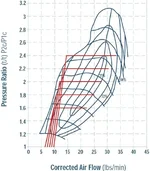Protege2ner said:If im not mistaken the 14.7 is a ratio as in 14.7:1. It is the stoiciometric air/ fuel ratio ("read" perfect mix). Atmosperic pressures are usually alot higher unless expressed in BAR
You are getting confused because 14.7psi atmospheric which = 1 bar, or 1 atm or 101 Pa is roughly the same number as the AFR ratio of 14.7:1 that is stoichometric. But it is not a ratio in pressure terms... 14.7 is the the absolute PSI pressure of atmospheric... if you run 14.7 psi of boost you are running 1 bar or 1 atm of boost, but you have a pressure ratio of 2.0 because you have (14.7+14.7)/2 And that Pressure Ratio (PR) is what you need in combo with engine air consumption (cfm or lb/min or m^3/min or kg/min) to read a compressor map.

